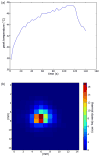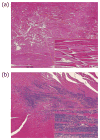MRI-based prediction of pulsed high-intensity focused ultrasound effect on tissue transport in rabbit muscle
- PMID: 23553784
- PMCID: PMC3706525
- DOI: 10.1002/jmri.24087
MRI-based prediction of pulsed high-intensity focused ultrasound effect on tissue transport in rabbit muscle
Abstract
Purpose: To design an algorithm for optimizing pulsed high intensity focused ultrasound (p-HIFU) treatment parameters to maximize tissue transport while minimizing thermal necrosis based on MR image guidance.
Materials and methods: P-HIFU power, duty cycle, and treatment duration were varied to generate different levels of thermal and mechanical deposition in rabbit muscle. Changes in T2-weighted and T1 contrast-enhanced (CE) signal were assessed immediately following treatment and at 24 h. Transport parameters were extracted by means of T1-weighted dynamic contrast-enhanced MRI (DCE-MRI) technique at 0 and 24-h time points.
Results: Successful p-HIFU treatment was indicated by focal hyperintensity on the T2-weighted image immediately post-treatment, suggesting increased fluid (edema), with little intensity change in CE image. After 24 h, the affected region expanded along the muscle fiber accompanied by clear hyperintensity in CE image (contrast uptake). Quantitative DCE-MRI analysis revealed statistically significant increases in both leakage rate and extracellular space, accompanied by a decrease in clearance rate.
Conclusion: Successful p-HIFU treatment was mainly correlated to tissue heating. Tissue transport properties following treatment success would result in improved contact between drug and targets in both time and space. MRI is the key to controlling treatment by means of thermometry and also monitoring efficacy by means of T2-weighted imaging.
Keywords: MRI-guided focused ultrasound; clearance rate; drug delivery; dynamic contrast enhanced-MRI; pulsed high-intensity focused ultrasound; tissue permeability.
Copyright © 2013 Wiley Periodicals, Inc.
Figures










Similar articles
-
Evolution of the ablation region after magnetic resonance-guided high-intensity focused ultrasound ablation in a Vx2 tumor model.Invest Radiol. 2013 Jun;48(6):381-6. doi: 10.1097/RLI.0b013e3182820257. Invest Radiol. 2013. PMID: 23399810
-
Real-time monitoring of high-intensity focused ultrasound thermal therapy using the manifold learning method.Ultrasound Med Biol. 2014 Dec;40(12):2841-50. doi: 10.1016/j.ultrasmedbio.2014.07.021. Ultrasound Med Biol. 2014. PMID: 25438863
-
Cluster analysis of DCE-MRI data identifies regional tracer-kinetic changes after tumor treatment with high intensity focused ultrasound.NMR Biomed. 2015 Nov;28(11):1443-54. doi: 10.1002/nbm.3406. Epub 2015 Sep 21. NMR Biomed. 2015. PMID: 26390040
-
MRI methods for the evaluation of high intensity focused ultrasound tumor treatment: Current status and future needs.Magn Reson Med. 2016 Jan;75(1):302-17. doi: 10.1002/mrm.25758. Epub 2015 Jun 22. Magn Reson Med. 2016. PMID: 26096859 Review.
-
High-intensity focused ultrasound: principles, therapy guidance, simulations and applications.Z Med Phys. 2012 Dec;22(4):311-22. doi: 10.1016/j.zemedi.2012.07.001. Epub 2012 Aug 10. Z Med Phys. 2012. PMID: 22884198 Review.
Cited by
-
Non-lethal heat treatment of cells results in reduction of tumor initiation and metastatic potential.Biochem Biophys Res Commun. 2015 Aug 14;464(1):51-6. doi: 10.1016/j.bbrc.2015.05.093. Epub 2015 May 29. Biochem Biophys Res Commun. 2015. PMID: 26032500 Free PMC article.
-
Enhancing tissue permeability with MRI guided preclinical focused ultrasound system in rabbit muscle: From normal tissue to VX2 tumor.J Control Release. 2017 Jun 28;256:1-8. doi: 10.1016/j.jconrel.2017.04.017. Epub 2017 Apr 12. J Control Release. 2017. PMID: 28412225 Free PMC article.
-
Development of a high-field MR-guided HIFU setup for thermal and mechanical ablation methods in small animals.J Ther Ultrasound. 2015 Aug 13;3:14. doi: 10.1186/s40349-015-0035-6. eCollection 2015. J Ther Ultrasound. 2015. PMID: 26269744 Free PMC article.
-
Modulation of the interstitial fluid pressure by high intensity focused ultrasound as a way to alter local fluid and solute movement: insights from a mathematical model.Phys Med Biol. 2014 Nov 21;59(22):6775-95. doi: 10.1088/0031-9155/59/22/6775. Epub 2014 Oct 20. Phys Med Biol. 2014. PMID: 25327766 Free PMC article.
-
Real-time assessment of high-intensity focused ultrasound heating and cavitation with hybrid optoacoustic ultrasound imaging.Photoacoustics. 2023 May 10;31:100508. doi: 10.1016/j.pacs.2023.100508. eCollection 2023 Jun. Photoacoustics. 2023. PMID: 37228577 Free PMC article.
References
-
- Yuh EL, Shulman SG, Mehta SA, et al. Delivery of systemic chemotherapeutic agent to tumors by using focused ultrasound: study in a murine model. Radiology. 2005;234:431–437. - PubMed
-
- Dittmar KM, Xie J, Hunter F, et al. Pulsed high-intensity focused ultrasound enhances systemic administration of naked DNA in squamous cell carcinoma model: Initial experience. Radiology. 2005;235:541–546. - PubMed
-
- Frenkel V, Etherington A, Greene M, et al. Delivery of liposomal doxorubicin (Doxil) in a breast cancer tumor model: Investigation of potential enhancement by pulsed-high intensity focused ultrasound exposure. Academic Radiol. 2006;13:469–479. - PubMed
-
- Khaibullina K, Jang BS, Sun H, et al. Pulsed high intensity focused ultrasound enhances uptake of radiolabeled monoclonal antibody to human epidermoid tumor in nude mice. J Nucl Med. 2008;49:295–302. - PubMed
Publication types
MeSH terms
Grants and funding
LinkOut - more resources
Full Text Sources
Other Literature Sources

